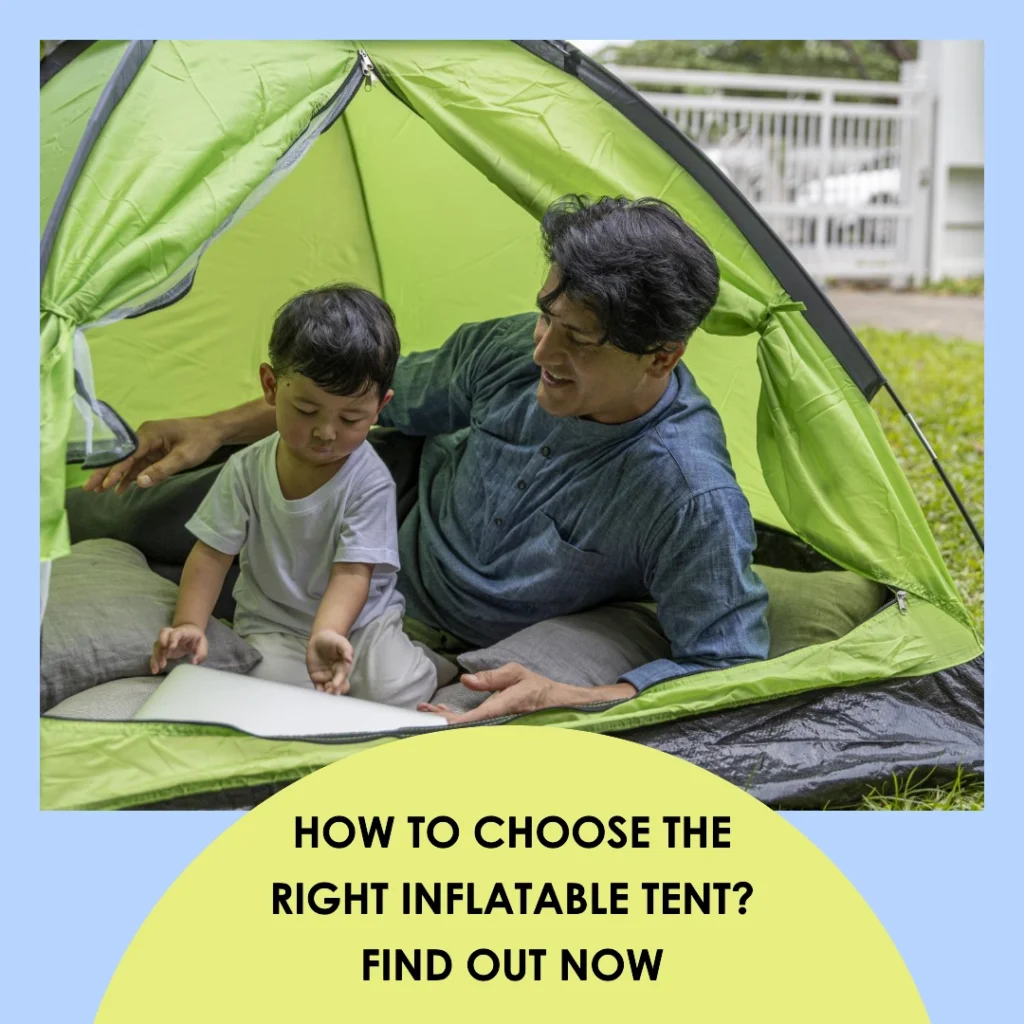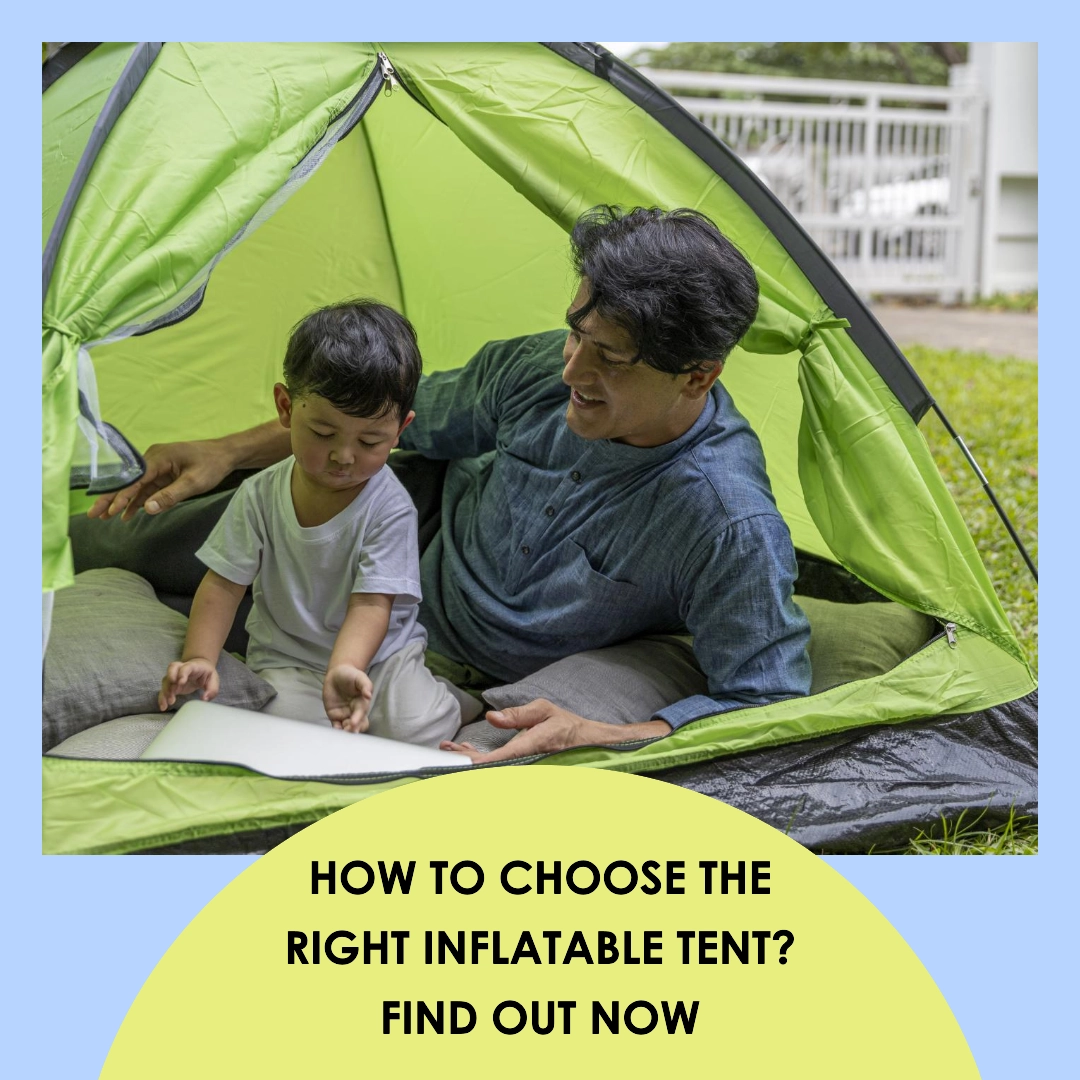Choosing the right inflatable tent is a critical decision for any outdoor enthusiast. In this guide, I’ll explore the essential factors to consider when selecting your ideal shelter. From durability to ease of setup, I’ll cover it all. Additionally, I’ll delve into the age-old debate of inflatable tent vs pole options, helping you make an informed choice for your camping adventures. Let’s simplify the process so you can confidently embark on your next outdoor experience with the perfect inflatable tent.

What is the Importance of choosing the right inflatable tent?
Here are some of the key reasons why it’s important to choose the right inflatable tent:
- Comfort – The right tent will provide ample room to move around and sleep comfortably without feeling cramped. This is vital for an enjoyable camping trip.
- Weather Protection – You’ll want an inflatable tent that can withstand the weather conditions you plan to use it in. A tent built with durable, waterproof materials will keep you dry in the rain and resilient to the wind.
- Quick Setup – Inflatable tents pump up rapidly to minimize the time and effort involved with pitching a tent. This enables you to start enjoying your camping excursion faster.
- Portability – Inflatable tents weigh less than standard tents and pack down much smaller for easy transport. This makes them ideal for backpacking, festival camping, and other trips where lightweight gear is preferred.
- Durability – While cheaper inflatable tents might save you money upfront, they tend to lack reinforcements and robust construction, resulting in quicker damage. Spending a bit more on a quality tent will pay off through years of reliable use.
- Ventilation – Proper airflow and temperature regulation keep condensation to a minimum so you stay dry and comfortable inside. Breathable fabrics and ventilation flaps are a must during hot summer trips.
Advantages of using inflatable tents
When it comes to camping, having the right gear can make all the difference in your overall experience. One of the key advantages of using inflatable tents is their ease of setup. Unlike traditional tents that require poles and stakes, inflatable tents can be set up in a matter of minutes. Simply inflate the tent using a pump, and you’re ready to go. This not only saves you time but also eliminates the need for complicated instructions or struggling with tangled poles.
Another advantage of inflatable tents is their portability. Most inflatable tents are designed to be lightweight and compact, making them easy to carry and transport. This is especially beneficial for backpackers or those who like to move around frequently during their camping trips. Additionally, inflatable tents can be deflated and packed away quickly, allowing for hassle-free storage when not in use.
Inflatable tents also offer superior comfort compared to traditional tents. The air-filled chambers provide a cushioned and insulated sleeping surface, which can help you get a good night’s sleep even on uneven terrain. The inflatable structure also helps to distribute weight evenly, reducing the risk of sagging or collapsing during the night. Overall, inflatable tents offer a comfortable and cozy camping experience that is hard to match with other types of tents.
How to Choose the Right Inflatable Tent?
To choose the right inflatable tent, you need to consider many important things. Here are the key things you must consider to choose the right inflatable tent for you.
Purpose of use
What will you use the tent for? Determine if you need a tent for backyard camping, festivals, beach trips, or rugged backcountry excursions. Your intended purposes will dictate what size, features, and durability you require.
Size
Consider the number of people the tent should fit and how much gear needs to be stored inside. Inflatable tents come in a range of sizes from small 2-person models up to large family-sized options. Make sure to choose a tent with adequate capacity.
Material Polyester Nylon PVC Vinyl
Pay attention to the materials used. Polyester and nylon are light yet durable. PVC and vinyl offer waterproofness at the expense of pack weight. High-denier fabrics also tend to be more abrasion-resistant.
Weather Resistance
Check the tent’s weather resistance specifications. Models built to withstand high winds, heavy rainfall, and other extreme conditions typically cost more but are vital for harsh environments.
Pumps
The included pump matters as high-volume pumps inflate tents faster. Rechargeable battery-powered pumps provide convenience, while manual pumps work perfectly well but require more effort.
Ventilation
Vents and windows provide much-needed airflow and visibility. Mesh screens keep insects out, while inner tent dividers allow for privacy.
Features
Inflatable tents often come with additional features that enhance comfort and functionality. Consider features like awnings for sun protection, multiple doors for easy access, and organizers for storing gear.
Ease of Setup
One of the primary advantages of inflatable tents is their ease of setup. However, some tents may require more effort than others. Check the manufacturer’s instructions and reviews to ensure the tent can be set up quickly and easily.
Portability
If you plan to hike or backpack with your inflatable tent, portability is a crucial factor. Consider the tent’s packed size and weight, ensuring it can be comfortably carried in your backpack.
Brand Reputation And Reviews
Choosing a reputable brand known for producing high-quality inflatable tents is essential. Read online reviews to gain insights into the brand’s reputation and the experiences of other users.
Price
Inflatable tents range in price depending on size, features, and brand. Set a budget and compare prices from different retailers to find the best value for your money.
Size and capacity of inflatable tents
Choosing the correct size tent and capacity is essential when selecting the ideal inflatable tents for your outdoor adventures. It’s not just about the number of people it can sleep, but also about ensuring there is enough space for everyone’s comfort and storage needs. This decision is crucial whether you’re looking for larger family tents or more compact two-person tents.
Firstly, evaluate the purpose of your tent. If it’s for family camping trips, you may need one of the larger family tents, which provide ample space for adults, children, and all the necessary gear. These tents often feature room dividers and separate living spaces, enhancing privacy and organization. On the other hand, if you’re a solo adventurer or a couple, a smaller, more streamlined tent might suit your needs better, offering efficiency without the bulk.
The size tent you choose also impacts your camping experience regarding setup, portability, and comfort. Larger tents provide more headroom and living space, making them ideal for longer stays or those camping with children. However, they can be heavier and take longer to set up. Smaller tents, such as two-person tents, are lighter and easier to carry, perfect for hiking or festivals, but they may offer limited space for gear and movement.
When considering the capacity, think about the layout and tent layout as well. Some tents boast additional features like awnings or screened porches, extending the living area without cramping the sleeping quarters. This can be particularly beneficial if you expect to spend a lot of time inside due to weather or if you’re camping with pets.
Material and durability of inflatable tents
When venturing into the great outdoors, your shelter is your sanctuary. Thus, the material and durability of inflatable tents become paramount. These tents, especially those crafted from robust materials, offer a shield against the unpredictable wilderness. Opting for weather resistance and conventional tents materials can significantly elevate your camping experience.
In the realm of inflatable tents, materials like polyester and nylon reign supreme due to their lightweight and water-resistant properties. High-denier fabrics contribute to the tent’s durability, ensuring a sturdier structure that can withstand varied environmental assaults. This is where conventional tents often fall short. Inflatable air tents leverage these advanced materials to marry lightness with strength, presenting a formidable challenge to traditional models.
However, it’s not just about the material but also the construction. Weather resistance is a critical factor; a tent’s ability to stand firm against wind, rain, and sun defines its value on the trail. Here, durable materials for inflatable tents come into play. They ensure longevity and protection, distinguishing good tents from the best. A tent with a strong, leak-resistant structure and UV protection ensures that it remains a trusty companion for years to come.
Moreover, the weather-resistant tents category showcases models equipped with additional protective layers. These tents not only resist water but also prevent UV degradation, an essential feature for those sun-drenched expeditions. In contrast, conventional tents may lack in this refined engineering, which positions newfangled inflatable tents as a superior choice for the savvy camper.
Set-up and take-down process of inflatable tents
The set-up and take-down process of inflatable tents is a pivotal aspect of their appeal, especially when compared to traditional tents. The hallmark of a quality inflatable tent is its ease of assembly, which can significantly enhance your camping experience. Air seconds and instant canopies are terms synonymous with this rapid deployment, underscoring the efficiency and convenience that modern campers seek.
When embarking on the set-up, the first step involves selecting an appropriate campsite—flat, free of sharp objects, and spacious enough to accommodate your tent. Once the location is set, unfold the tent and lay it out. The majority of inflatable tents come equipped with integrated air beams rather than conventional poles, which are the frameworks that provide the tent’s structure once inflated.
Utilizing the pump, either manual or electric, inflate each air beam according to the manufacturer’s instructions. The beauty of air seconds technology is its swift and straightforward nature—transforming a flat piece of fabric into a full-fledged shelter in minutes. This process eliminates the fumbling with poles and stakes, streamlining setup and allowing more time for enjoyment of the outdoors.
Conversely, the take-down process is equally streamlined. Begin by opening the valves to deflate the tent’s air beams. As the tent collapses, gently push out any remaining air and commence folding the fabric. Proper folding techniques, as outlined by the manufacturer, will ensure the tent fits back into its carry bag without issue. It’s advisable to remove any debris and dry the tent as much as possible before packing to prevent mold and mildew.
In conclusion, the setup and take-down of an inflatable tent are crucial factors to consider when choosing your outdoor shelter. The ease and speed of these processes are what set inflatable tents apart from traditional models. By opting for a tent with a user-friendly design, you can minimize hassle and maximize your time enjoying the great outdoors. Remember, a good start and end to your camping experience hinge on the simplicity of your tent’s assembly and storage.
Additional features and accessories for inflatable tents
When delving into the world of inflatable tents, it’s not just the structure itself that matters, but also the additional features and accessories that can enhance your camping experience. The inclusion of tent accessories like sewn-in groundsheets and tent stakes can significantly impact the functionality, comfort, and safety of your outdoor shelter. Consider the following features and accessories when choosing an inflatable tent:
- Vestibules: Some tents come with vestibules or awnings that provide extra storage space or a shaded area outside the tent. This can be useful for keeping muddy shoes, wet gear, or cooking equipment separate from the sleeping area.
- Ventilation: Look for tents with good ventilation systems to prevent condensation and keep the interior fresh and comfortable. Mesh windows and vents allow for airflow while keeping bugs out.
- Interior pockets: Having interior pockets or gear lofts can help you stay organized by providing storage space for small items such as phones, flashlights, and keys.
- Rainfly: A rainfly is an additional protective layer that covers the top of the tent, providing extra waterproofing and insulation. Some tents come with a built-in rainfly, while others may require it to be purchased separately.
- Groundsheet: A groundsheet or footprint is a protective layer that goes underneath the tent to provide insulation, prevent moisture from seeping in, and protect the tent floor from wear and tear. Some tents come with a built-in groundsheet, while others may require it to be purchased separately.
Additionally, customization options such as color-coded inflation points, reflective guylines, and adjustable pegging points can also enhance the practicality and safety of your tent. These must-have inflatable tent accessories and features not only add to the convenience but also to the safety and durability of your shelter.
In conclusion, when choosing your inflatable tent, don’t overlook the importance of additional features and accessories. From basic needs like tent stakes and sewn-in groundsheets to luxury additions like internal lighting and customizable airflow systems, these enhancements can transform your camping experience. Remember, the best campsite is one where you’re well-equipped, comfortable, and secure, so consider these additional features when planning your next outdoor adventure.
Cost and budget considerations for inflatable tents
When delving into the world of camping, particularly with inflatable tents, understanding the associated costs and budgeting accordingly is essential. These innovative shelters vary widely in price, influenced by size, material quality, brand reputation, and additional features. Setting a realistic budget that aligns with your camping needs while aiming for the best value can enhance your outdoor experience significantly.
The price spectrum for inflatable tents is broad, ranging from affordable options suited for occasional use to high-end models designed for frequent, rugged outings. Affordable inflatable tents may cater to budget-conscious campers, offering basic shelter without the bells and whistles. However, investing in a mid-range or premium tent might be more cost-effective in the long run, especially for those committed to regular camping. These tents, while initially more expensive, are typically crafted from superior materials, offering enhanced durability, weather resistance, and comfort.
Budget-friendly air tents can be tempting, particularly for first-time campers or those with limited outdoor commitments. However, it’s crucial to assess the tent’s features against your specific requirements. Consider the weather conditions you anticipate, the terrain, and the frequency of use. A cheaper tent might suffice for dry, mild conditions, but could fall short in harsh weather or after repeated use.
Moreover, factor in the long-term costs of ownership when selecting a tent. This includes maintenance, repairs, and potential upgrades. High-quality tents with robust construction and materials might require less frequent replacements, offering better long-term value. Additionally, some tents come with warranties or guarantees, providing added value and peace of mind.
Inflatable tent vs pole: which one is better?
The debate between inflatable tents and traditional pole tents has been ongoing among camping enthusiasts. Each type has its own set of advantages and disadvantages that cater to different camping styles and preferences. When deciding whether an inflatable tent or a pole tent is better for you, consider several factors such as setup time, portability, durability, and weather resistance.
Inflatable tents, also known as air tents, are renowned for their ease of setup. With no poles to assemble, these tents can be inflated within minutes using a pump, which is particularly beneficial for those seeking quick and straightforward setup after a long day of hiking or traveling. This ease extends to the take-down process; simply deflate, roll up, and pack away. In terms of stability, inflatable tents often fare well in windy conditions due to their flexible structure, which can absorb wind without bending or breaking.
On the other hand, traditional camping tents with poles have been the standard for decades. They are typically more affordable than their inflatable counterparts and come in a vast array of styles and sizes. However, pole tents can require more time and skill to set up, especially for larger models or in adverse weather conditions. That said, they tend to be lighter and more compact when packed down, making them a preferable option for backpackers and those with limited storage space.
Pros and Cons of inflatable tents
| Pros | Cons |
| Easy setup and inflate | Bulky and difficult to pack up |
| Stable in windy conditions | Difficult to repair if punctured or torn |
| Comfortable to sleep in | Expensive, especially for larger tents |
| Durable and less likely to tear or rip than pole tents | Custom or niche inflatable tents may have limited options |
| Weather resistant and can withstand rain, snow, and wind | |
| Lightweight and easy to transport | |
| Spacious and can accommodate a lot of people and gear | |
| Come in a variety of sizes to fit your needs | |
| Versatile and can be used in a variety of environments | |
| Deflates easily and packs into a small carrying bag |
Finally, the choice between an inflatable tent and a traditional tent hinges on your specific camping needs, budget, and personal preferences. While inflatable tents offer significant advantages in terms of setup and portability, they might not be suitable for everyone, particularly those who camp in colder climates or have a tighter budget. Conversely, traditional tents can be more affordable and simpler to repair but may lack the convenience and comfort provided by their inflatable counterparts. Balancing these factors will help determine the best tent type for your outdoor adventures.
Conclusion
Choosing the right inflatable tent is essential for a successful and enjoyable outdoor adventure. By considering factors such as size, material, ease of setup, weather resistance, and additional features, you can find a tent that meets your specific needs. Take the time to research different brands and models, read reviews, and ask for recommendations from fellow outdoor enthusiasts. Remember to properly maintain and care for your inflatable tent to ensure its longevity and performance.
So get ready to find the perfect inflatable tent that will take your outdoor adventures to the next level. Follow this comprehensive guide, and you’ll be well-equipped to choose an inflatable tent that suits your needs and preferences. Happy camping!

